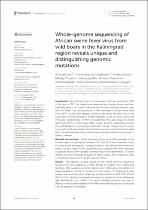| dc.contributor.author | Mazloum, Ali | |
| dc.contributor.author | van Schalkwyk, Antoinette | |
| dc.contributor.author | Shotin, Andrey | |
| dc.date.accessioned | 2023-06-19T09:48:13Z | |
| dc.date.available | 2023-06-19T09:48:13Z | |
| dc.date.issued | 2023 | |
| dc.identifier.citation | Mazloum, A. et al. (2023). Whole-genome sequencing of African swine fever virus from wild boars in the Kaliningrad region reveals unique and distinguishing genomic mutations. Frontiers in Veterinary Science, 9. https://doi.org/10.3389/fvets.2022.1019808 | en_US |
| dc.identifier.issn | 2297-1769 | |
| dc.identifier.uri | https://doi.org/10.3389/fvets.2022.1019808 | |
| dc.identifier.uri | http://hdl.handle.net/10566/9112 | |
| dc.description.abstract | Since the first report of outbreaks of African swine fever (ASF)
in Georgia in 2007, the disease has expanded into Europe, Russia, and Asia,
spreading rapidly via contact with infected animals including domestic pigs
and wild boars. The vast expansion of this Genotype II African swine fever
virus (ASFV) across wide-ranging territories and hosts inevitably led to the
acquisition of novel mutations. These mutations could be used to track the
molecular epidemiology of ASFV, provided that they are unique to strains
restricted within a certain area. Whilst whole-genome sequencing remains
the gold standard for examining evolutionary changes, sequencing of a single
locus with significant variation and resolution power could be used as a rapid
and cost-eective alternative to characterize multiple isolates from a single or
related outbreak. | en_US |
| dc.language.iso | en | en_US |
| dc.publisher | Frontiers Media | en_US |
| dc.subject | Biotechnology | en_US |
| dc.subject | Public health | en_US |
| dc.subject | Swine fever virus | en_US |
| dc.subject | Africa | en_US |
| dc.title | Whole-genome sequencing of African swine fever virus from wild boars in the Kaliningrad region reveals unique and distinguishing genomic mutations | en_US |
| dc.type | Article | en_US |

